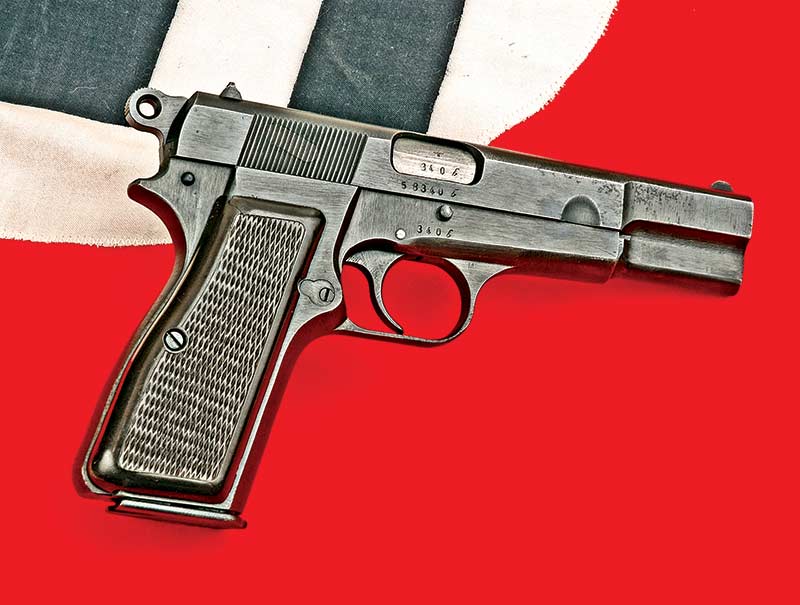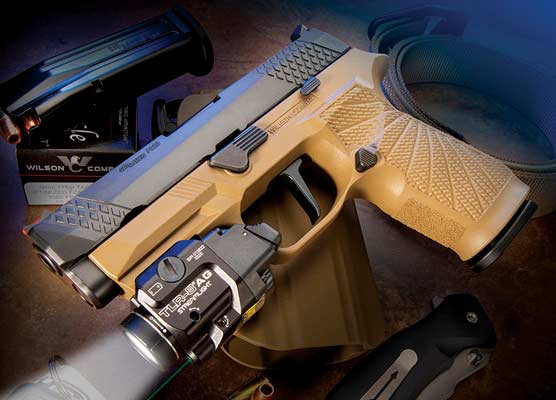Browning and FN’s indefatigable 9mm
A World-Wide Web
A little-known fact among modern handgunners is the Hi-Power was truly international in both manufacture and usage. FN had Hi-Powers in full production for only five years when the German Wehrmacht invaded Belgium. When the dust settled, the Germans instructed FN to continue production of it under the name 640b. Less formally, it was called the P35, short for Pistole 1935. Tens of thousands served in both Heer (army) and SS hands.
Around the same time, a Canadian firm with firearms manufacturing capability was tasked with duplicating them for issuance to the armed forces of Great Britain, China and Canada. This was the John Inglis Company Ltd., of Toronto. However, there was a problem. The engineering drawings were in Nazi-occupied Belgium. It’s believed some FN-made Hi-Powers were reverse engineering by Inglis’ draftsmen.
The Hi-Powers ordered by the Chinese from both FN before the war and Inglis during the war are very interesting. They have tangent rear sights graduated to 500 meters and were issued with wooden shoulder stocks also serving as holsters. Logically, the British and Canadian ordnance officers who placed orders for Inglis Hi-Powers considered the shoulder stocks and tangent sights as ridiculous. Their Hi-Powers had a simple notched rear with dovetailed front blade.
Post-World War II, FN continued to make Hi-Powers, and according to the book Military Small Arms of the 20th Century by Ian Hogg and Charles Weeks, no fewer than 55 nations adopted the pistol for their armies. If Hi-Powers are not still in some military organizations’ holsters today, I’ll eat John Taffin’s hat.
A Higher Power
Iwas saddened to hear Browning discontinued the Hi-Power in 2018. It was ahead of its time when introduced in 1935, and still as practical an autoloading pistol as you can get at its demise 83 years later. Beyond being a great design, it was also a trendsetter with its 13-round magazine making it one of the first, if not the actual first, double-column 9mm pistols.
The Hi-Power was John M. Browning’s last design. He passed away in 1926 while residing in Belgium and working with the Fabrique Nationale firm. At his death, another talented firearms designer at FN named Dieudonne Saive took over. FN’s Hi-Power was introduced almost a decade later.
Coming Around
The Browning Hi-Power’s use extended well past military service. They’ve been popular in this country for decades for defense and target competition. I fired my first one in 1971 and was duly impressed with its fit and finish. However, I never actually owned a Hi-Power until about 2006 when I was putting together my World War II firearms collection. Then I purchased a Chinese-style Inglis, one complete with shoulder stock and an FN variant with Nazi stamps.
During my shooting of World War II Lugers and P38 9mms, there were occasional stoppages. The ammunition was both factory and handloads with various bullet types such as FMJs, JSPs and cast bullet RNs. Neither of my Hi-Powers hesitated with any ammunition fed to them.
In 2015 I found myself in need of a “modern” 9mm for an article, so I turned to Browning for a Hi-Power. Interestingly, its parts were produced in Belgium but assembled in Portugal. It was a fine quality pistol and, like its older military brethren, it gave nary a bobble with any sort of ammunition. If I’d known it was going to be dropped in 2018 I might have purchased it instead of sending it back when the loan time was up.
My guess is the new, curveless, blocky, soulless, synthetic pistols spelled the demise of Browning’s all-steel Hi-Power. I find this to be a true shame for a gun with its pedigree that’s soldiered on for so long.







